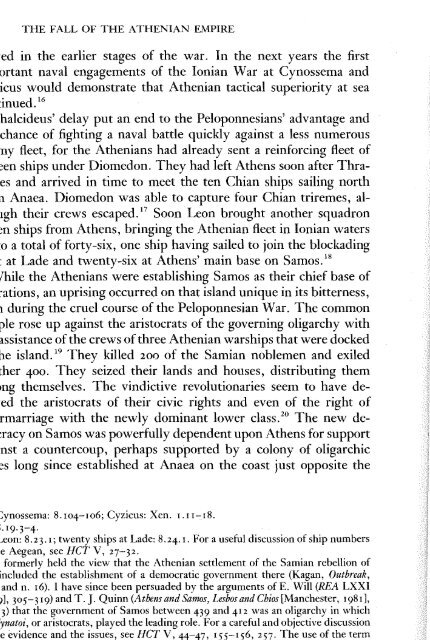The Fall of the Athenian Empire-(A New History of the Peloponnesian War) Donald Kagan - (1987)
MACEDONIA is GREECE and will always be GREECE- (if they are desperate to steal a name, Monkeydonkeys suits them just fine) ΚΑΤΩ Η ΣΥΓΚΥΒΕΡΝΗΣΗ ΤΩΝ ΠΡΟΔΟΤΩΝ!!! Strabo – “Geography” “There remain of Europe, first, Macedonia and the parts of Thrace that are contiguous to it and extend as far as Byzantium; secondly, Greece; and thirdly, the islands that are close by. Macedonia, of course, is a part of Greece, yet now, since I am following the nature and shape of the places geographically, I have decided to classify it apart from the rest of Greece and to join it with that part of Thrace which borders on it and extends as far as the mouth of the Euxine and the Propontis. Then, a little further on, Strabo mentions Cypsela and the Hebrus River, and also describes a sort of parallelogram in which the whole of Macedonia lies.” (Strab. 7.fragments.9) ΚΚΕ, ΚΝΕ, ΟΝΝΕΔ, ΑΓΟΡΑ,ΕΚΚΛΗΣΙΑ,ΝΕΑ,ΦΩΝΗ,ΦΕΚ,ΝΟΜΟΣ,LIFO,MACEDONIA, ALEXANDER, GREECE,IKEA
MACEDONIA is GREECE and will always be GREECE- (if they are desperate to steal a name, Monkeydonkeys suits them just fine)
ΚΑΤΩ Η ΣΥΓΚΥΒΕΡΝΗΣΗ ΤΩΝ ΠΡΟΔΟΤΩΝ!!!
Strabo – “Geography”
“There remain of Europe, first, Macedonia and the parts of Thrace that are contiguous to it and extend as far as Byzantium; secondly, Greece; and thirdly, the islands that are close by. Macedonia, of course, is a part of Greece, yet now, since I am following the nature and shape of the places geographically, I have decided to classify it apart from the rest of Greece and to join it with that part of Thrace which borders on it and extends as far as the mouth of the Euxine and the Propontis. Then, a little further on, Strabo mentions Cypsela and the Hebrus River, and also describes a sort of parallelogram in which the whole of Macedonia lies.”
(Strab. 7.fragments.9)
ΚΚΕ, ΚΝΕ, ΟΝΝΕΔ, ΑΓΟΡΑ,ΕΚΚΛΗΣΙΑ,ΝΕΑ,ΦΩΝΗ,ΦΕΚ,ΝΟΜΟΣ,LIFO,MACEDONIA, ALEXANDER, GREECE,IKEA
You also want an ePaper? Increase the reach of your titles
YUMPU automatically turns print PDFs into web optimized ePapers that Google loves.
ATHENS RESPONDS 57<br />
island. 21 Consequently, <strong>the</strong> A<strong>the</strong>nians judged <strong>the</strong>m to be entirely trustworthy<br />
and granted <strong>the</strong>m autonomy. 22 That trust was vindicated, for<br />
<strong>the</strong> Samian democracy remained loyal to <strong>the</strong> A<strong>the</strong>nians throughout<br />
<strong>the</strong> war, even after <strong>the</strong> A<strong>the</strong>nian navy was destroyed at Aegospotami. 23<br />
With Samos secure, <strong>the</strong> A<strong>the</strong>nians were in a position to challenge<br />
<strong>the</strong> ambitions <strong>of</strong> <strong>the</strong> still-zealous men <strong>of</strong> Chios. Eager to expand <strong>the</strong><br />
number <strong>of</strong> rebels, <strong>the</strong> Chians did not wait for significant Spartan aid<br />
to arrive before moving ahead with <strong>the</strong> program agreed upon <strong>the</strong> previous<br />
spring at Corinth. 24 With thirteen ships under <strong>the</strong> Laconian<br />
perioikos Deiniadas, <strong>the</strong>y sailed to Lesbos and immediately brought<br />
Methymna into rebellion, leaving four ships <strong>the</strong>re to lend support.<br />
<strong>The</strong> o<strong>the</strong>rs <strong>the</strong>n sailed on to Mytilene and caused it, too, to rebel. At<br />
<strong>the</strong> same time, a land army <strong>of</strong> <strong>Peloponnesian</strong>s, <strong>the</strong> sailors from Chalcideus'<br />
ships who had been left at Chios,Z 5 and <strong>the</strong> allies from <strong>the</strong><br />
neighborhood marched northward along <strong>the</strong> mainland coast under <strong>the</strong><br />
command <strong>of</strong> <strong>the</strong> Spartan Eualas. 26 Starting probably from Erythrae,<br />
<strong>the</strong>y passed through Clazomenae, Phocaea, and Cyme, apparently<br />
bringing those important cities over to <strong>the</strong>ir side. 27<br />
Meanwhile, <strong>the</strong> Spartans had broken through <strong>the</strong> blockade at Spiraeum,<br />
with <strong>the</strong> loss <strong>of</strong> four ships. <strong>The</strong> survivors refitted at Cenchreae<br />
and sailed for Ionia under <strong>the</strong> command <strong>of</strong> Astyochus, <strong>the</strong> new navarch<br />
sent to take command <strong>of</strong> <strong>the</strong> entire <strong>Peloponnesian</strong> fleet. 28 He arrived<br />
''For Anaea, see HCT V, 42, 4s-46; Quinn, A<strong>the</strong>ns and Samos, Lesbos and Chios, 17-<br />
I9.<br />
22<br />
What precisely was implied by this grant is unclear. Perhaps <strong>the</strong>y were given some<br />
judicial privilege (G. E. M. de Ste. Croix, CQ LV = N. S. 11 [I96I], 272). Possibly,<br />
<strong>the</strong>y were given <strong>the</strong> right to strike coins, as J. P. Barron (<strong>The</strong> Silver Coins <strong>of</strong> Samos<br />
[London, I966], 100-IOI) suggests. <strong>The</strong> gesture was probably <strong>of</strong> more psychological<br />
than practical importance, bespeaking a special relationship <strong>of</strong> trust and confidence<br />
between <strong>the</strong> two democracies and promising a new relationship after <strong>the</strong> war. Some<br />
scholars connect IG 1 2 IOI (see D. M. Lewis, BSA XLIX [19S4], 29-3 I) with this grant<br />
<strong>of</strong> autonomy, but <strong>the</strong> inscription is not dated and is too fragmentary to be useful.<br />
"Xen. 2.2.6.<br />
24<br />
8.8.2.<br />
"8.I7.I; HCT V, so.<br />
26<br />
8.22.<br />
27<br />
HCT V, so.<br />
28 8.20. I. <strong>The</strong>re has been considerable debate about whe<strong>the</strong>r at this time <strong>the</strong> navarchy<br />
was a regular, annual <strong>of</strong>fice, undertaken and relinquished at specific times <strong>of</strong> <strong>the</strong> year.<br />
<strong>The</strong> most influential affirmative argument was made by Beloch (GG Il 2 :2, 269-289).<br />
<strong>The</strong> most recent negative argument is made by R. Sealey (Klio LVIII [I976], BS-<br />
358), who believes that <strong>the</strong> navarchy was made a regular magistracy with a fixed term<br />
only about 409. Until <strong>the</strong>n, he believes, <strong>the</strong> navarch was appointed for specific tasks,<br />
and his term ended with completion <strong>of</strong> <strong>the</strong> task. (For briefer, but useful discussions,

















